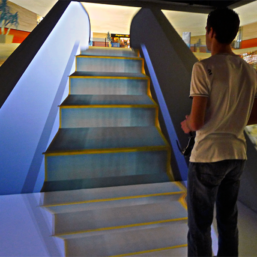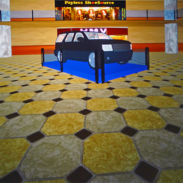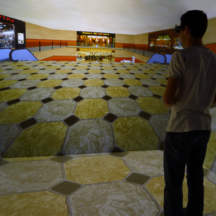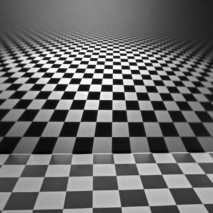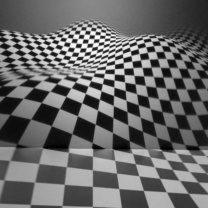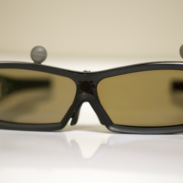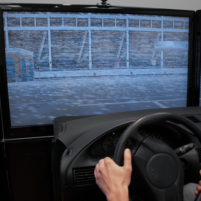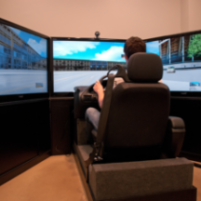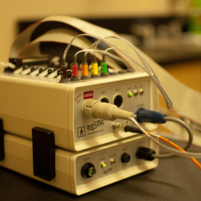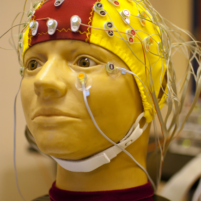Technology
Icube
The EON Icube™ is a PC based multi-sided immersive environment in which participants are completely surrounded by virtual imagery and 3D sound. Objects float in 3D space, can be touched and manipulated by users, and can be changed in real-time.
EON Icube used software and high-end active stereo projectors, with stereoscopic glasses and motion tracking position trackers. Motion trackers are implemented to monitor the user’s position and orientation and are used to calculate a stereoscopic perspective view while allowing the user to freely move into and around the objects floating in space.
Peripheral devices such as wands and gesture gloves are integrated into the system.
Source : Eon reality
Cave
The CAVE is an advanced display system of the size of a room. It combines stereoscopic projection and high-resolution 3D computer graphics to create the illusion to be present in a virtual environment.
The CAVE was the first technology of virtual reality in the world, which made it possible to several users to be immersed entirely in the same virtual environment at the same time.
The CAVE is available with four, five or six projected surfaces allowing a complete virtual immersion.
Car driving simulator
The VS500M is a high fidelity fully immersive car simulator. High quality graphics, 3D sound with a high fidelity motion provides an simulated driving experience in a real car cockpit environment.
The Virage Simulation Simulator consists of an open cabin with the driver seat and center console of a GM compact car, a fully functional instrument and warning light cluster, a wide visual display and a three-axis motion / vibration system.
The visual optical system consists of a five-channel PC-based image generator and three 52” LCD displays that provide 180 degrees front view. Two side screens provide additional visual feedback for the left and right blind zones. The high-resolution system generates 1920 x 1080 pixels per front display, 60 Hz refresh frequency, as well as antialiasing and anisotropic filtering for high quality, stable real time rendering.
Rear view and side view mirrors are simulated through a window inset within the main screen. A rear display is available as an option to perform parallel parking or other activities requiring rear view.
Source : Virage Simulation
Électro-encéphalographie (EEG)
Is the recording of electrical activity along the scalp produced by the firing of neurons within the brain. EEG refers to the recording of the brain’s spontaneous electrical activity over a short period of time as recorded from multiple electrodes placed on the scalp.
Material:
- 64 electrodes for EEG signal recording (active electrodes) + 2 reference electrodes (CMS/DRL)
- Amplificateur : ActiveTwo AD-box (BioSemi®), and a generator : Battery-box (BioSemi®)
- USB2 Reciever (BioSemi®)
- LabVIEW (BioSemi®)
Signal processing:
- EEGLab for MATLAB (MathWorks®)
Experiements:
- Visual Evoked Potential (PEV).
EYE TRACKER
Eye tracking is the process of measuring either the point of gaze (“where we are looking”) or the motion of an eye relative to the head. An eye tracker is a device for measuring eye positions and eye movement. Eye trackers are used in research on the visual system, in psychology, in cognitive linguistics and in product design. There are a numberof methods for measuring eye movement. The most popular variant uses video images from which the eye position is extracted. Other methods use search coils or are based on the electrooculogram.
Source: Wikipédia
Biofeedback
Biofeedback is a learning process in which people are taught to improve their health and performance by observing signals generated by their own bodies. It is scientifically based and validated by studies and clinical practice.
The word “biofeedback” was coined to describe laboratory procedures that trained research subjects to alter brain activity, blood pressure, muscle tension, heart rate and other physiological responses often thought to have been beyond voluntary control. Biofeedback-assisted physical changes are accompanied by feelings of relaxation, improved motor control, and often by relief of dysfunctional physical and/or emotional symptoms.
Biofeedback is non-invasive. When used clinically, a therapist attaches sensors or electrodes to the body and these sensors provide a variety of readings–feedback–which is displayed on equipment, usually a meter or a computer, for the patient to see. One commonly used device called the electromyogram (EMG), for example, picks up electrical signals from the muscles. It translates the signals into a form that people can detect, such as a flashing light and/or a beeper, every time muscles become more tense. If one wants to relax tense muscles, one must try to slow down or eliminate the flashing or beeping. People learn to associate sensations from the muscle with actual levels of tension and develop a new, healthy habit of keeping muscles only as tense as is necessary for as long as necessary. After treatment, individuals are then able to repeat this response at will without being attached to the sensors.
Other biological functions which are commonly measured and used in these ways are skin temperature, heart rate (EKG, BVP), sweat gland activity (GSR, SC), respiration, and brainwave activity (EEG), also called NeurofeedbackClinicians rely on electronic biofeedback systems in somewhat the same way that you would rely on a thermometer. Their systems can detect a person’s internal bodily functions with far greater sensitivity and accuracy than a person can alone. With this information, patients can learn to make changes so subtle that at first they may not be consciously perceived. This information may be valuable, as both patients and therapists can use it to gauge and direct the progress of treatment.
Studies have shown that we have more control over supposedly involuntary bodily functions than we ever thought possible. Researchers have proved that many individuals can alter their involuntary responses by being “fed back” information either visually or audibly about what is going on in their bodies. As a result, biofeedback can train individuals with techniques for living a healthier life overall – whether one has a medical condition or not.
Source: Thought Technology
Imagerie optique
À venir…


